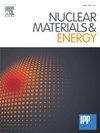A new method for preparing high-quality and fatigue-resistant divertor W/Cu joints
IF 2.3
2区 物理与天体物理
Q1 NUCLEAR SCIENCE & TECHNOLOGY
引用次数: 0
Abstract
Due to the insolubility between W and Cu and the inability to generate intermetallic compounds, connecting W and Cu poses a considerable challenge. In this study, a casting assisted vacuum hot pressing (VHP) method is adopted to join W and Cu, and the process parameters are optimized. The casting temperature is 1180 °C and the most suitable bonding parameters are a bonding temperature of 650 °C, a bonding pressure of 25 MPa and a bonding time of 90 min. The obtained W/Cu joint exhibits an average shear strength of 138.0 MPa and with no detectable defects on the interface. The effective bonding area of W/Cu joints exceed 98 %. The thermal conductivity of W/Cu prepared by casting assisted VHP is 347, 288, and 257 W/m·K at room temperature, 500 °C, and 900 °C, respectively, exceeding that of W/Cu prepared by casting assisted hot isostatic pressing (HIP) at the corresponding temperatures. The heat transfer performance and structural integrity of the prepared divertor mockup remain satisfactory after 1000 cycles at 20 MW/m2, with a peak surface temperature of 725.7 ℃. The proposed method provides a new strategy for preparing high-performance and fatigue resistant W/Cu joints, to address the issues of low bonding performance as well as poor fatigue resistance.
求助全文
约1分钟内获得全文
求助全文
来源期刊

Nuclear Materials and Energy
Materials Science-Materials Science (miscellaneous)
CiteScore
3.70
自引率
15.40%
发文量
175
审稿时长
20 weeks
期刊介绍:
The open-access journal Nuclear Materials and Energy is devoted to the growing field of research for material application in the production of nuclear energy. Nuclear Materials and Energy publishes original research articles of up to 6 pages in length.
 求助内容:
求助内容: 应助结果提醒方式:
应助结果提醒方式:


